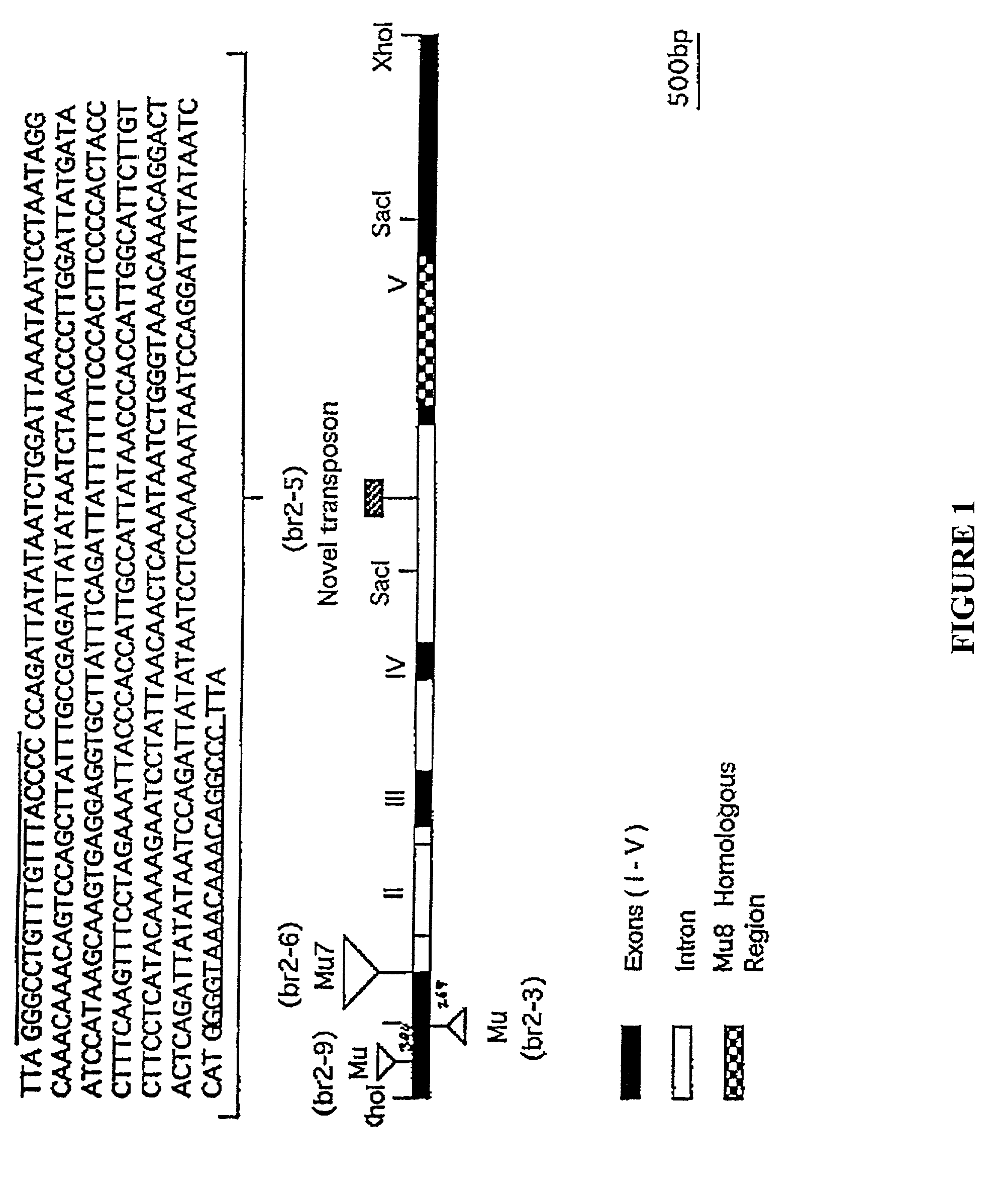Isolated nucleic acid molecules encoding the Br2 P-glycoprotein of maize and methods of modifying growth in plants transformed therewith
a technology of p-glycoprotein and nucleic acid molecules, which is applied in the field of genetic manipulation of organisms, can solve the problems of not being able to use commercially acceptable dwarf varieties for all crops, no growth retardants registered for use on grapes, fruit trees and peanuts, and the regulation of this trait in plants is a fairly complicated process, so as to enhance the resistance of plants to pathogens.
- Summary
- Abstract
- Description
- Claims
- Application Information
AI Technical Summary
Benefits of technology
Problems solved by technology
Method used
Image
Examples
example 1
Mapping the Location of br2 on Chromosome 1L
[0108]Previous genetic studies revealed that br2 was located on maize chromosome 1L within 0.1 cM of hm1. In an F2 population of 1500 plants between the br2 recombinant mutant tester (br2br2Hm1Hm1) and Pr (a maize inbred homozygous recessive at the hm1 locus; Br2hm1hm1), only one recombinant (hm1hm1br2br2) was found between br2 and hm1. However, the orientation of these two genes in relation to each other was not determined. To address whether br2 is proximal or distal to hm1, the progeny of the above recombinant and its progenitors was RFLP genotyped using probes from the hm1 gene as well as two RFLP markers, PIO200644 and PIO200044. These DNA markers flank hm1, with PIO200644 and PIO200044 mapping 5 cM proximal and distal to hm1, respectively (Johal et al. (1992) Science 258:985–987). The PIO200044 allele of the recombinant tester was the same as the original br2 tester whereas the hm1and PIO200644 alleles had recombined, indicating that...
example 2
Transposon Tagging and Cloning of br2
[0109]To clone the wild-type Br2 gene, a directed (targeted) tagging approach was used in which Robertson's Mutator (Mu) was used as the genetic mutagen (Robertson (1978) Mutation Res. 51:21–28; Walbot (1992) Annu. Rev. Plant Physiol Plant Mol. Biol. 43:49–82). Crosses were made between Mu-containing Br2 / Br2 females and the recombinant mutant tester (described in Example 1) containing the br2 reference (br2-ref) allele. A total of 90,000 hybrid plants from the resulting F1 population were planted in the field that yielded 35 dwarf plants. These putative br2 mutants were propagated by crossing with B73 (an inbred) females as well as by backcrossing to the br2 tester. The latter set of crosses, which essentially tested allelism between br2-ref and the new brachytic mutant alleles, was performed to evaluate which of the 35 new mutants were heritable and not caused by environmental factors. The brachytic stature of maize plants can be mimicked by pla...
example 3
Identity of the Br2 Gene and the Protein it Encodes
[0117]To ascertain the molecular nature of Br2, both XhoI clones were fully sequenced. This allowed the compilation an approximately 7.0 kb stretch of the genomic region of the br2 locus that appears to contain more than 90% of the Br2 coding region (SEQ ID NO: 1). When this sequence was subjected to BLAST analysis, it revealed that the predicted br2 protein has an extensive sequence and structural similarity with the multidrug-resistance (MDR)-like gene-encoded P-glycoproteins (Gottesman et al. (1995) Annu. Rev. Genet. 29:607–649; Borst et al. (1997) Trends Genet. 13:217–222; Croop (1998) Methods Enzym. 292:101–116). The products of the MDR-like genes belong to the family of ATP-binding cassette-containing (ABC) transporters that mediate the ATP-driven transmembrane translocation a large variety of substrates (Gottesman et al. (1995) Annu. Rev. Genet. 29:607–649; Higgins (1992) ) Annu. Rev. Cell Biol. 8:67–113). More than 67% amino...
PUM
| Property | Measurement | Unit |
|---|---|---|
| Antisense | aaaaa | aaaaa |
Abstract
Description
Claims
Application Information
 Login to View More
Login to View More - R&D
- Intellectual Property
- Life Sciences
- Materials
- Tech Scout
- Unparalleled Data Quality
- Higher Quality Content
- 60% Fewer Hallucinations
Browse by: Latest US Patents, China's latest patents, Technical Efficacy Thesaurus, Application Domain, Technology Topic, Popular Technical Reports.
© 2025 PatSnap. All rights reserved.Legal|Privacy policy|Modern Slavery Act Transparency Statement|Sitemap|About US| Contact US: help@patsnap.com

